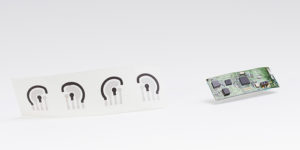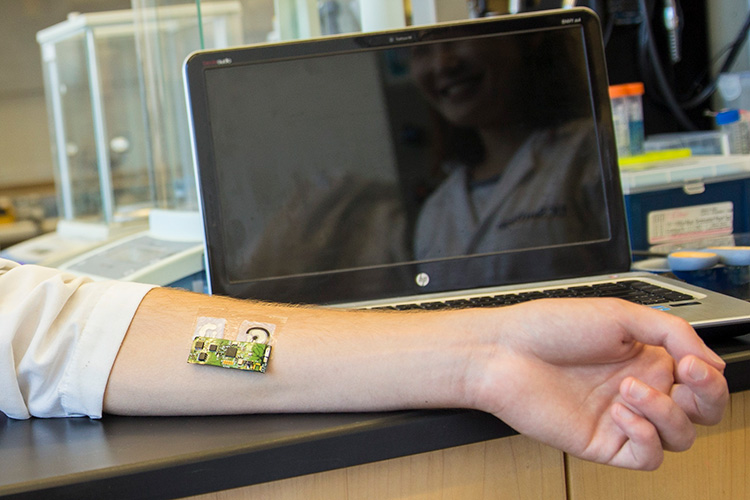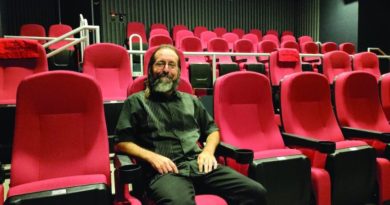Daily Business Report-Aug. 4, 2016
Flexible wearable sensor for detecting alcohol level can be worn on the arm. (UC San Diego News Center)
Flexible Wearable Electronic Skin Patch
Offers New Ways to Monitor Alcohol Levels
By Liezel Labios | UCSD
Engineers at the University of California San Diego have developed a flexible wearable sensor that can accurately measure a person’s blood alcohol level from sweat and transmit the data wirelessly to a laptop, smartphone or other mobile device. The device can be worn on the skin and could be used by doctors and police officers for continuous, non-invasive and real-time monitoring of blood alcohol content.
The device consists of a temporary tattoo—which sticks to the skin, induces sweat and electrochemically detects the alcohol level—and a portable flexible electronic circuit board, which is connected to the tattoo by a magnet and can communicate the information to a mobile device via Bluetooth. The work, led by nanoengineering professor Joseph Wang and electrical engineering professor Patrick Mercier, both at UC San Diego, was published recently in the journal ACS Sensors.

“Lots of accidents on the road are caused by drunk driving. This technology provides an accurate, convenient and quick way to monitor alcohol consumption to help prevent people from driving while intoxicated,” Wang said. The device could be integrated with a car’s alcohol ignition interlocks, or friends could use it to check up on each other before handing over the car keys, he added.
“When you’re out at a party or at a bar, this sensor could send alerts to your phone to let you know how much you’ve been drinking,” said Jayoung Kim, a materials science and engineering PhD student in Wang’s group and one of the paper’s co-first authors.
Blood alcohol concentration is the most accurate indicator of a person’s alcohol level, but measuring it requires pricking a finger. Breathalyzers, which are the most commonly used devices to indirectly estimate blood alcohol concentration, are non-invasive, but they can give false readouts. For example, the alcohol level detected in a person’s breath right after taking a drink would typically appear higher than that person’s actual blood alcohol concentration. A person could also fool a breathalyzer into detecting a lower alcohol level by using mouthwash.
Recent research has shown that blood alcohol concentration can also be estimated by measuring alcohol levels in what’s called insensible sweat—perspiration that happens before it’s perceived as moisture on the skin. But this measurement can be up to two hours behind the actual blood alcohol reading. On the other hand, the alcohol level in sensible sweat—the sweat that’s typically seen—is a better real-time indicator of the blood alcohol concentration, but so far the systems that can measure this are neither portable nor fit for wearing on the body.
Now, UC San Diego researchers have developed an alcohol sensor that’s wearable, portable and could accurately monitor alcohol level in sweat within 15 minutes.
“What’s also innovative about this technology is that the wearer doesn’t need to be exercising or sweating already. The user can put on the patch and within a few minutes get a reading that’s well correlated to his or her blood alcohol concentration. Such a device hasn’t been available until now,” Mercier said.
___________________________________________
NASSCO Hosts Keel Laying Ceremony
for Future Hershel ‘Woody’ Williams Ship
General Dynamics NASSCO hosted a keel laying ceremony on Tuesday for the future USNS Hershel “Woody” Williams, the U.S. Navy’s second Expeditionary Sea Base (ESB) currently under construction at the company’s San Diego shipyard.

The ship’s namesake, Hershel Woodrow “Woody” Williams, spoke at the ceremony, and his two daughters, Travie Ross and Tracie Ross, welded their initials onto the keel of the ship. Williams, a retired U. S. Marine, received the Medal of Honor for his actions in the Battle of Iwo Jima during World War II. He is the last surviving recipient of the Medal of Honor from that battle.
“The story of Hershel ‘Woody’ Williams is remarkable. It’s a story of valiant devotion, extraordinary courage and American heroism,” said Kevin Graney, vice president and general manager for General Dynamics NASSCO. “We have the distinct honor of constructing a ship that will reflect the strength and fearlessness of its namesake and will provide global, advanced capabilities for future generations of Marines and sailors to come.”
USNS Hershel “Woody” Williams is the Navy’s second ESB ship. The 784-foot-long ship will serve as a flexible platform to support a variety of missions, including air mine countermeasures, counter-piracy operations, maritime security and humanitarian missions.
The ship will provide for accommodations for up to 250 personnel, a 52,000-square-foot flight deck, fuel and equipment storage, and will also support MH-53 and MH-60 helicopters with an option to support MV-22 tilt-rotor aircraft. The ship is expected to be completed in the first quarter of 2018.
General Dynamics NASSCO has delivered three ships in the class to the Navy. Hershel “Woody” Williams is the fourth ship to be constructed by NASSCO shipbuilders under the program and a fifth ship is currently under contract for advanced procurement.
___________________________________________

Northrop Grumman Begins Work on
2nd Japanese E-2D Hawkeye Aircraft
Northrop Grumman Corp. has received a U.S. Navy contract to begin production of a second Japanese E-2D Advanced Hawkeye airborne early warning and surveillance aircraft.
The first Japanese E-2D is in production and will be delivered in 2018.
The aircraft will be produced at the company’s Aircraft Integration Center of Excellence in St. Augustine, Fla. Northrop Grumman will manufacture the Japanese E-2D on the same multiyear production line used for U.S. aircraft, which allows for a more efficient and affordable delivery schedule. The E-2D is the world’s only airborne early warning aircraft in production.
“We are honored to continue this strong partnership through the E-2D program, which brings Japan a powerful new tool that meets their immediate airborne surveillance needs and facilitates information sharing across many platforms, making it a force multiplier for the future as well,” said Jane Bishop of Northrop Grumman.
In 2014, the Japanese Ministry of Defense competitively selected the E-2D to fulfill the nation’s airborne early warning requirements. The Japan Air Self-Defense Force has operated the E-2C Hawkeye since the 1983. The E-2C is also currently used by Taiwan, France and Egypt.
___________________________________________
Taxpayers Group Backs Sales Tax Hike
For $18 Billion in Transit Repairs
By City News Service
The San Diego County Taxpayers Association on Wednesday endorsed a November ballot measure to raise the region’s sales tax by a half-cent to pay for infrastructure projects.
The San Diego County Road Repair, Transit, Traffic Relief, Safety and Water Quality Measure would raise an estimated $18 billion over 40 years to improve freeways, fund municipal road repairs and build a trolley line between San Ysidro and Kearny Mesa, among other things.
“The Taxpayers Association supports SANDAG’s plan to improve public transportation and mobility for the following reasons — the agency operates effectively and efficiently, it has an excellent track record of leveraging state and federal funds for local projects, it delivers on its promises to voters, and this plan will reduce traffic and commute times, which will improve our quality of life,” said Haney Hong, the taxpayer group’s president and CEO.
The funds would also pay for brush clearance, synchronization of traffic signals and boost water recycling efforts, supporters said.
___________________________________________
Report: Trans-Pacific Partnership
Would Benefit San Diego
By City News Service
Though heavily criticized on the presidential campaign trail, the Trans-Pacific Partnership trade agreement would benefit San Diego’s export economy by lowering tariffs in other Pacific Rim countries, according to a report released Wednesday.
The report by the UC San Diego School of Global Policy and Strategy and the San Diego World Trade Center notes that 97 percent of local exports — worth more than $22 billion — go to countries that have signed on to the TPP. Trade to TPP nations from San Diego has increased by 73 percent over the last 14 years, according to the authors.
San Diego’s export economy, which encompasses a wide variety of manufactured and agricultural goods, is tied up more with TPP signatories than the U.S. as a whole.
Meanwhile, only Canada has less restrictive trade policies than the U.S. among TPP countries, so adopting the agreement would “level the playing field for U.S. firms in foreign markets,” the report says.
U.S. Secretary of Commerce Penny Pritzker joined local business leaders to brief the media on the report.
A coalition of environmental, labor, health, consumer advocacy and rights organization have combined to fight implementation of the 12-nation deal, which has been introduced in Congress but not ratified.
Republican presidential nominee Donald Trump is strongly against the agreement, while his opponent, Hillary Clinton, has backed it in the past but criticized it during the primary campaign. Her Democratic Party primary opponent, Sen. Bernie Sanders of Vermont, was also resolutely opposed to it.
President Barack Obama reiterated his support for TPP at a news conference on Tuesday, calling it an opportunity to expand economies and set equitable trade rules. He acknowledged, however, that globalization and technology advances have not benefited everyone.
The TPP, if it takes effect, would open markets, phase out thousands of tariffs and impose new trade rules that address labor rights and environmental standards on the dozen Pacific Rim nations that signed on.
___________________________________________
Personnel Announcements
Lourdes Menendez Joins Simon’s Fashion Valley

Simon’s Fashion Valley has hired Lourdes Menendez as the new director of marketing and business development.
Menendez was previously the director of marketing and business development for Simon’s The Falls shopping center in Miami, Fla.
In her new role, Menendez will lead overall marketing strategies such as event programming, social media, guest services, public relations and advertising. She will manage various business functions encompassing tourism, revenue generation, marketing budgets and tenant and partner relationships.
Prior to joining the Simon team in 2013, Menendez served as marketing and sponsorship coordinator for the Dolphin Mall in Miami. She also has previous experience in marketing and sales, having worked for Daily Me, an online customized news website, and for Hispanic Market Weekly, an online subscription-based newsletter.
The Kleinfelder Group Names President and CEO
George J. Pierson has been named president and CEO of The Kleinfelder Group, a San Diego engineering, construction management, design and environmental professional services firm.
Pierson currently serves as president and CEO of The Pierson Advisory Group. Prior to that, he was president and CEO of Parsons Brinckerhoff, a 130-year-old global engineering and program management firm with 14,000 employees in 150 worldwide offices. He held this position from 2010 to 2014. During his five-year tenure as President and CEO, the firm added nearly $1.4 billion of shareholder value.



